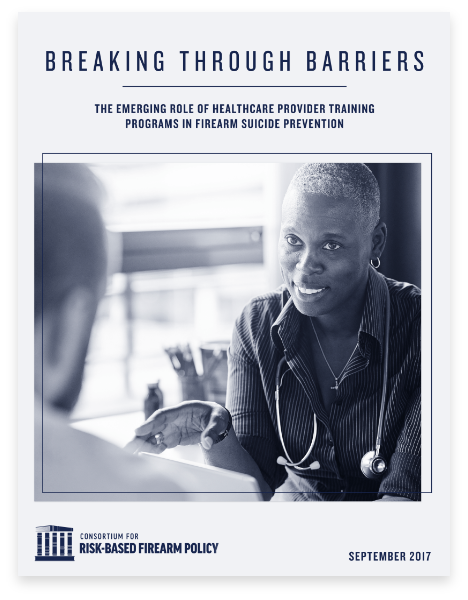Lethal Means Safety Counseling
What is lethal means safety counseling?
Lethal means safety counseling is an effective, evidence-based healthcare intervention that prevents firearm injury and death by helping patients and families reduce access to guns for those at risk.
Lethal means safety counseling is the process that healthcare providers undertake to:
- Determine if a person at risk of injury or death has access to lethal means, like guns; and
- Work with the person and their family or friends to reduce access to guns until the risk subsides.
Every patient at an elevated risk of firearm injury (or their parent or guardian, as appropriate) should receive lethal means safety counseling, even if they do not have access to a gun at the time of the counseling; (see When Should Lethal Means Safety Counseling Be Used? for more on when patients may be at risk). Family or friends should be included in the counseling if possible. All patients, regardless of risk level, should be asked about firearm access and given general information on firearm safety.
The Consortium for Risk-Based Firearm Policy recommends that lethal means safety counseling:
- Be straightforward, practical, and respectful;
- Focus on concern for the patient’s safety;
- Include direct questions about gun access and intent to access guns;
- Explain the risks of easy access to lethal means;
- Provide options for safer storage; and
- Use motivational interviewing techniques as one way to explore barriers to and pros/cons of safer storage options.2
Breaking Through Barriers: Consortium report on lethal means safety counseling

For a deeper dive, or if you are a healthcare provider, administrator, or educator seeking to include lethal means safety counseling in your practice, policy, or teaching, please see the Consortium for Risk-Based Firearm Policy’s report on lethal means safety counseling and training.
Why is lethal means safety counseling important?
Gun violence is a public health crisis in the United States. In 2018, nearly 40,000 people died by gun violence – over 100 deaths every single day.3 Healthcare providers have an important opportunity to engage at-risk patients and help them temporarily limit their access to firearms during periods of high risk, which ultimately saves lives.
Easy access to firearms turns risky situations deadly:
- Guns are the most lethal suicide attempt method, with approximately 9 out of 10 firearm suicide attempts resulting in death.4
- The firearm homicide rate in the United States is 25.2 times higher than other industrialized countries.5 Guns are used in nearly three-quarters of homicides in the United States.6
- Unsecured firearms increase risk of unintentional injury and death. Americans are four times more likely to die from an unintentional gun injury than those in comparable countries.7
- A woman is five times more likely to be murdered when her abuser has access to a gun.8
Mitigating access to firearms with safer storage practices prevents gun violence. One way to reduce access to guns for people at risk or during high-risk time periods is through lethal means safety counseling.
When should lethal means safety counseling be used?
| Condition | Examples | How to Respond When Patients Have Firearm Access |
|---|---|---|
| ACUTE RISK Acute risk of violence to self or others (based on information or behavior) |
|
|
| INDIVIDUAL RISK FACTORS Individual-level risk factors for violence to self or others or unintentional firearm injury |
|
|
| DEMOGRAPHIC GROUP Member of a demographic group at increased risk for violence to self or others or unintentional firearm injury |
|
|
Chart adapted from: Wintemute GJ, Betz ME, & Ranney M.L. (2016). Yes, you can: Physicians, patients, and firearms. Annals of Internal Medicine.
The 5 Ls
The 5 Ls is a mnemonic to help guide healthcare providers in asking key questions and engaging in lethal means safety conversations about firearms storage in cases where their patient (or the patient’s parent/guardian) indicates that a firearm is in the home.

The 5 Ls mnemonic was proposed in: Pinholt EM, Mitchell JD, Butler JH, & Kumar H. (2014). “Is there a gun in the home?” Assessing the risks of gun ownership in older adults. Journal of the American Geriatrics Society.
For resources on safer firearm storage practices, see the Safer Storage page on our affiliate website, PreventFirearmSuicide.com.
Prevent Firearm Suicide
Prevent Firearm Suicide provides an overview of lethal means safety counseling, an effective approach to suicide prevention and other forms of firearm injury and death. In addition, this website provides general facts, statistics, and frequently asked questions about firearm suicide, a map detailing state-specific firearm suicide facts, and a resources tab for those seeking more information.
Is lethal means safety counseling effective?
Lethal means safety counseling prevents firearm injuries and deaths by improving firearm storage practices. Studies show that interventions by healthcare providers can influence patients’ gun storage practices, which in turn can substantially lower risk of suicide or other firearm-related injury.9 For example:
- Among patients who owned or lived with someone who owned a gun, researchers found that patients who received a family physician’s verbal or combined verbal and written safer storage recommendation were three times more likely to make safe changes in firearm storage practices than patients who did not receive counseling.10
- In another study, researchers found that for every five gun-owning parents whose child’s pediatrician gave them lethal means safety counseling and free cable locks, two parents reported using the cable locks six months later.11
If you or someone you know needs some support now, please contact the National Suicide Prevention Lifeline at 1-800-273-TALK (8255) or text “HOME” to 741-741.
Recommendations
Train healthcare professionals on lethal means safety counseling so they are prepared to ask patients about firearm access and provide effective and respectful counseling when appropriate.
Health care providers have an important opportunity to engage in firearm injury prevention by providing lethal means safety counseling to patients or parents/guardians of pediatric patients who may be at risk of violence to self or others.
Lethal means safety counseling should be an essential part of healthcare. Education on lethal means safety counseling should be offered to all healthcare providers in training and repeated throughout their careers. Lethal means safety counseling training should equip healthcare providers to deal tactfully, respectfully, and directly with the issues of firearm risks, safety, and storage. Additional research on lethal means safety counseling is needed, including best practices for counseling and best practices for training healthcare providers on how to provide the most effective method of counseling.
All patients should be asked about firearm access and provided safer storage information. Individuals at elevated risk of harm to self or others should receive more in-depth lethal means safety counseling from their health care providers. The following groups of people should receive counseling:
- Individuals expressing suicidal or homicidal ideation or intent
- Individuals who have risk factors for violence to self or others or unintentional firearm injury, including:
- History and/or threats of violent behavior
- Risky alcohol or substance use
- History of violent victimization
- Dementia or conditions impairing cognition and judgment
For more information, read the Consortium for Risk-Based Firearm Policy’s lethal means safety report and visit our Prevent Firearm Suicide website.
Resources
Educational Materials
Fact sheets
Reports
- Consortium for Risk-Based Firearm Policy: Breaking Through Barriers: The Emerging Role of Healthcare Provider Training Programs in Firearm Suicide Prevention
Websites
- Prevent Firearm Suicide’s page on lethal means safety counseling
Read More
- September 2017 blog, Healthcare Providers’ Role in Firearm Suicide Prevention
- October 2016 blog, Eight Actions Public Health Professionals Can Take to Stop Gun Violence
Research
- Allchin A, Chaplin V, & Horwitz J. (2018). Limiting access to lethal means: Applying the Social Ecological Model for firearm suicide prevention. Injury Prevention.
- Barber C, Hemenway D, & Miller M. (2016). How physicians can reduce suicide-without changing anyone’s mental health. American Journal of Medicine.
- Betz ME, Ranney ML, & Wintemute GJ. (2017). Physicians, patients, and firearms: The courts say “yes”. Annals of Internal Medicine.
- Betz ME & Wintemute GJ. (2015). Physician counseling on firearm safety: A new kind of cultural competence. Journal of American Medical Association.
- Kuhls DA, Falcone RA, Bonne S, Bulger EM, Campbell BT, Cooper Z, Dicker RA, Duncan TK, Kuncir EJ, Lamis DA, Letton RW, Masiakos PT, Stewart, RM, & Knudson MM. (2020). Prevention of firearm injuries: It all begins with a conversation. Journal of Trauma and Acute Care Surgery.
- Runyan CW, Brooks-Russell A, & Betz ME. (2019). Points of influence for lethal means counseling and safe gun storage practices. Journal of Public Health Management and Practice.
- Siry B, Betz M, Azrael D, Knoepke C, Simpson S, Omeragic F, & Matlock D. (2020). A pilot trial of suicidal adults within emergency departments: Enrollment challenges and strategies related to firearm access. SAGE Research Methods Cases.
- Simonetti JA & Rowhani-Rahbar A. (2019). Limiting access to firearms as a suicide prevention strategy among adults: What should clinicians recommend? Journal of American Medical Association.
- Wintemute GJ, Betz ME, & Ranney ML. (2016). Yes, you can: Physicians, patients, and firearms. Annals of Internal Medicine.
Additional Resources
- Center for Deployment Psychology, Uniformed Services University of the Health Sciences’s Lethal Means Safety Counseling to Reduce Suicide Risk free online training
- Lock to Live, an evidence-based decision-making aid for safer storage of lethal means
- Harvard T.H. Chan School of Public Health’s Means Matter initiative
- University of California Davis’s What You Can Do Initiative
- University of California Firearm Violence Research Center’s BulletPoints Project
- U.S. Department of Veterans Affairs’ MIRECCs (Mental Illness Research, Education and Clinical Centers) and CoEs (Centers of Excellence)’s Lethal Means Safety & Suicide Prevention resource page
- Suicide Prevention Resource Center (SPRC)’s Counseling on Access to Lethal Means (CALM) free online training
Last updated July 2020

